Unit1
1. 1) A entertaining B entertainment C entertained D entertainer
2) A recognizable B recognized C recognition D
3) A tempting B temptation C tempt
4) A reasoned B reasoning C reasonable D reason
5) A analyzed B analytical C analyst D analysis
6) A valuable B valuation C valued/values D values
7) A humorist B humor C humorous D humorless
8) A understandable B understanding C understand D misunderstood
2. 1) a sense of responsibility
2) a sense of safety/security
3) a sense of
inferiority
4) a sense of superiority
5) a sense of rhythm
a sense of justice
7) a sense of shame
8) a sense of helplessness
6)
9)
a sense of direction
10) a sense of urgency
3. 1) Lively behavior is normal
2) Fast cars appeal to
3) diverse arguments
4) I asked my boss for clarification
5) sensitive to light
6) Mutual
encouragement
7) made fun of him
8) persists in his opinion/viewpoint
9) to be the focus/center of
attention
10) we buy our tickets in advance
4. 1) certain/sure
2) involved
3) end
4) behavior
5) disciplining
6)
agreed
7)
individually
8) first
9) response
10) question
11) attempt
12)
voice
13) directly
14) followed
15) trouble
�
Unit2
Step One
Column A
through
up
draw
teen
hand
birth
chair
rag
ever
over
long
self
mile
type
well
Step Two
Column B
The Compound Words created
day
man
eared
ready
conscious
back
distance
beat
lift
age
due
stone
out
throughout
upbeat, uplift
drawback
teenage
handout, handwritten
birthday, birthstone
chairman
rag-eared
ever-ready
overdue, overage
long-distance, long-eared
self-conscious
mileage, milestone
wishing
typewriter, typewritten
Writer/written
well-wishing, well-written
1)
long-distance
2) upbeat
3) ever-ready
4) overdue
5) typewriter
6) milestone
7) handwritten
8) uplifted
9) self-conscious
10)
rag-eared
11) birthday
12) throughout
13) drawbacks
14) chairman
15) teenage
3. 1) thrives
2) strategy
3) annual
4) deserve
5) spontaneous
6) sincere
�
7) investments
8) enterprise
9) follow up
10) characterized
11)
lingered
12) acknowledged
4. column
1) D
2) A
3) B
4) C
tough
1) D
2) B
3) E
4)
F
5) C
6) A
6. 1) searched
2) clever
3) solution
4) wasted
5) tolerate
6) hidden
7)
dumb
8) subject
9) noise
10) extra
11) purchased
12) replaced
13)
appreciation
14) hurried
15) warrant
16) strange
Unit 3
Understanding the Organization of the Text
(1)
Introduction (para 1)
It has been proven repeatedly that the various types of behavior, emotions,
and
interests that constitute being masculine and feminine are patterned by both
heredity
and culture.
(2)
There is a cultural bias in education that favors boys over girls. (para. 2-4)
Supporting evidence
A.
Teachers called on males in class far more than on female students. (para 2)
i)
Its consequence: This has a tremendous impact on the learning process.
ii)
The reason for this: Active classroom participants develop more positive
attitudes
�
and go on to higher achievement.
iii) Two examples:
a.
In many of the former all-women’s colleges, the boys were taking
over the class-room discussions and active participation by women students had
diminished noticeably.
b.
A similar subordination of female to male students has also
been observed in law and medical school classrooms in recent years.
B.
Teachers assigned boys and girls different tasks according to stereotyped
gender roles. (para. 3)
i)
Its consequence: This prevented girls from participating as actively
as boys in class.
ii)
An example: A teacher had the little boys perform the scientific
experiment while the girls were given the task of putting the materials away.
C.
Gender-biased education is also reflected in the typical American teacher’
assumption. (para 4)
i)
The assumption: Boys will do better in the hard, masculine subjects
of math and science while girls are expected to have better verbal and reading skills.
ii) Three examples:
a. American boys do develop reading problems, while girls, who are
superior to boys in math up to the age of nine, fall behind from then on.
b. In Germany, all studies are considered masculine and it is girls
who develop reading problems.
c. In Japan, where early education appears to be nonsexist, both girls
and boys do equally well in reading.
(3)
The educational bias begins at home. (para 5)
A.
Supporting evidence:
i)
Boy preschoolers were permitted to go away from home in a much
wider area than girl preschoolers.
ii)
Boys were encouraged to develop intellectual curiosity and
physical skills, while girls are filled with fears of the world outside the home
and with the desire to be approved of for their goodness and obedience to rules.
B.
The consequence when these lessons carry over from the home to the
classroom: Girls are generally observed to be more dependent on the teacher, more
concerned with the form and neatness of their work than its content, and more anxious
about being right in their answers than in being intellectually independent,
analytical, or original.
C. Conclusion: Through the educational process that occupies most of the
child’s waking hours, society reinforces its established values and turns out each
�
sex in its traditional and expected mold.
Vocabulary
1. 1) genetic
2) assign
3) noticeably
4) approved
5) Bias
6)
deprived
7)
constituted
8) participation
9) unintentional
10)
postgraduate
2.conscious- unconscious
encourage- discourage
directly- indirectly
sexist – nonsexist
dependent- independent
positive – negative
superior - inferior
biased – fair
limited – unlimited
appropriately- inappropriately
3. 1)
C
2) D
3) A
4) E
5) B
6) C
7) F
8) B
4. 1) turn out
2) carry over
3) calling on
4) put away
5) fallen behind
6) take over
�
unit4
Reading Comprehension
1. 1) Introduction(para 1)
It is introduced in the article how teachers and parents can
encourage
creativity in children.
2) An important strategy for parents and teachers to follow (para. 2-3)
A. The strategy:
To encourage children to spend time thinking and developing new ideas.
B.
The significance for adopting the strategy:
If children can be taught to think creatively, they will be better
able to
function
in tomorrow’s society.
3) The definition of creativity (para. 4-5)
A.
Who successful students and adults are:
Those who can find a number of ways to approach problems.
B. What creative people can do:
They can use what they have to produce original ideas that are good
for
something.
4)
A big problem in school (para. 6)
The problem: Children can obtain and give back information, but can’
t figure
out ways to apply what they know in new situations.
5) A new approach to teaching (para 7)
A. The approach: Combining the basics with the activities where students must
use their imaginations.
B. How to do so: By asking questions and meanwhile praising their ideas and
new thoughts.
C. How to facilitate the process: To create an atmosphere in which there is
no
valued,
risk in being creative-- a place where wild ideas are honored and
never scorned or dismissed.
6)
Things parents can do at home to encourage creativity (para. 8-10)
A.
To involve children in decision making.
�
B.
C.
reason
To help children to understand the consequences of various decisions.
To encourage them to talk out loud about things they are doing. The
for doing so: Talking out loud improves language skills and
thinking skills.
D.
To show a sense of humor. The reason for doing so: Children can see
creativity in its purest form.
E.
To give children choices from their earliest age.
Examples:
a.
When they are very young, let them choose between two food items for
lunch.
b.
B. When they grow older, let them decide how to use their time or spend
their money.
Vocabulary
3. 1) dismiss
2) consequences
3)
promoting
4) applies
5) vital
6)
scorned
7) conventional
8) original
4. 1) consciously
2) innovative
3) unconsciously
4) determined
5)
Imagination
6) aware
7) control
8) created
9) extension
10) technique
11)
vulnerable
12) unfolding
13) joyful
14) gain
15) Apply
Unit5
Understanding the organization of the text
1) Introduction (para. 1)
Athletes are chosen to be role models, and they can choose only to be good
or
bad ones.
2) Athletes should be role models. (para. 2-5)
The author’s arguments:
A. Athletes should not refuse the responsibility of being a role model while
accepting all the glory and the money that comes with being a famous athlete.
(para. 2)
B. I try to be a positive role model, but that doesn’t mean I am perfect. (para.
�
3)
C. Qualities of a positive role model: (para. 4)
a.
b.
c.
He influences people’s lives in a positive way.
He gives of himself in time or money to help those who look up to him.
He displays the values like honesty and determination.
D.
Athletes cannot take the place of parents, but can help reinforce what parents
try to teach their children. (para. 5)
3)
People sometimes expect so much that some athletes don’t want to be role
modes. (para. 6-7)
A. Sometimes people put athletes on a pedestal.
Example: I have had parents in Utah put my picture on the wall beside Jesus
Christ. (para. 6)
B. Constantly being watched by the public can be hard to tolerate at times.
Example: 1: Negative publicity Michael Jordan received about gambling.
2. Ever since I played on the Dream Team, I can’t go
anywhere
buy a
without being the center of attention and I can’t even
motorcycle I really want. (para. 7)
4) Conclusion (para 8-9)
The good things about being a role model outweigh the bad.
A.
It’s a great feeling to think you are part of the reason that a id decided
to try
to be good.
B.
C.
But parents should remind their kids that there are no perfect human beings.
Charles Barkley is a good role model.
Vocabulary
2.
1) is bound to
2) follow their lead
3) goes too far/is going too far
4) take the place of
5) dropped out
6) have a fit
7) measure up to
8) look up to
9) Let’s face it
10) you name it
3.
1) outgrown
2) outdo
3) outwitted
4) outweigh
5) outlived
UNIT 7
1. belief – doubt deep- shallow learn- unlearn shame- pride inadequate-adequate
�


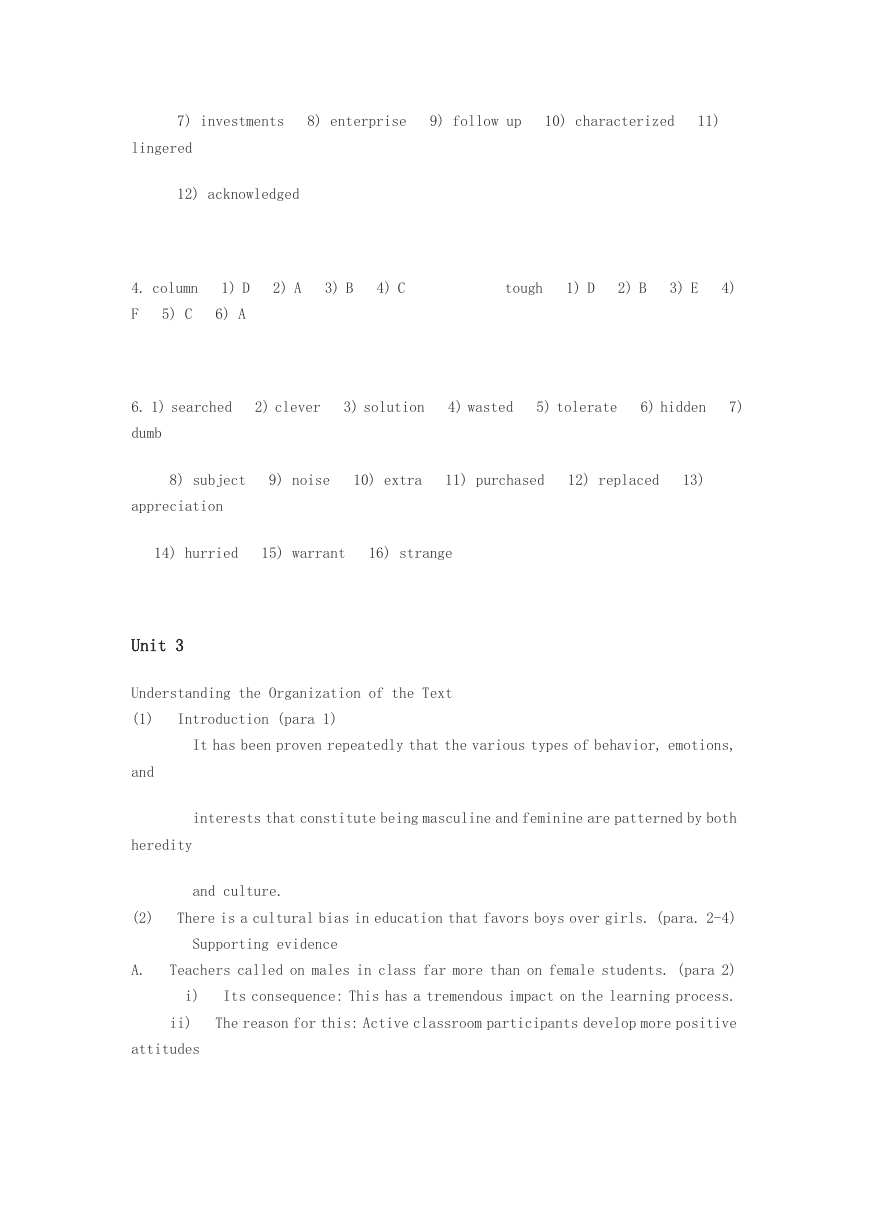
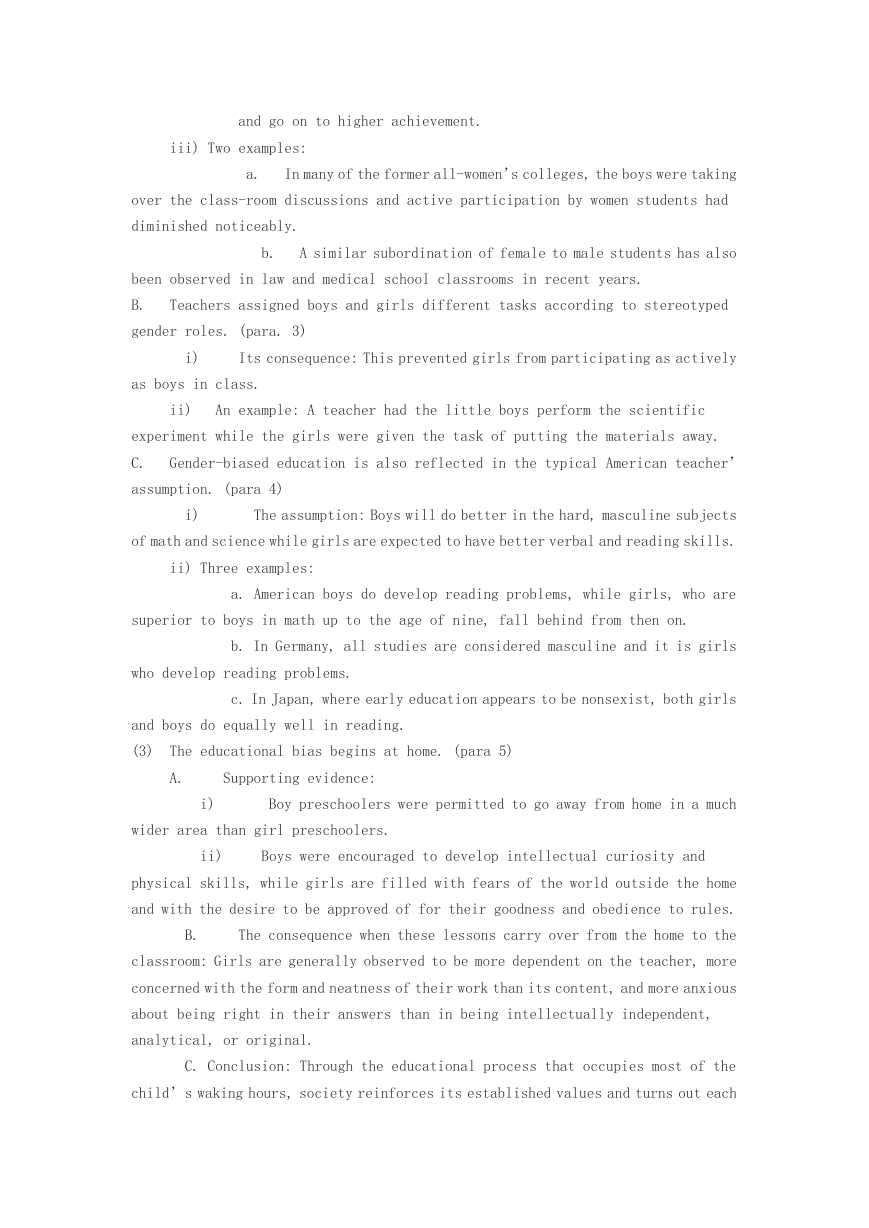

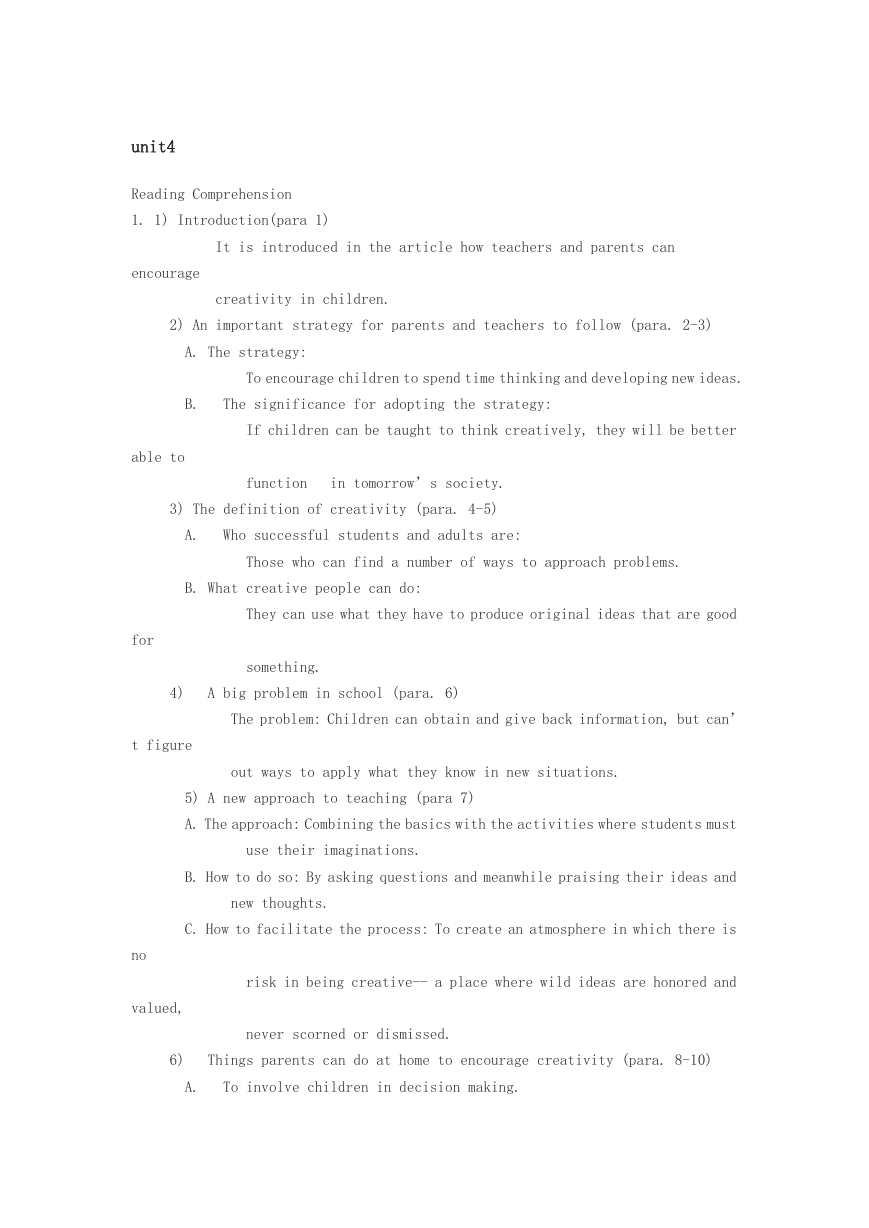
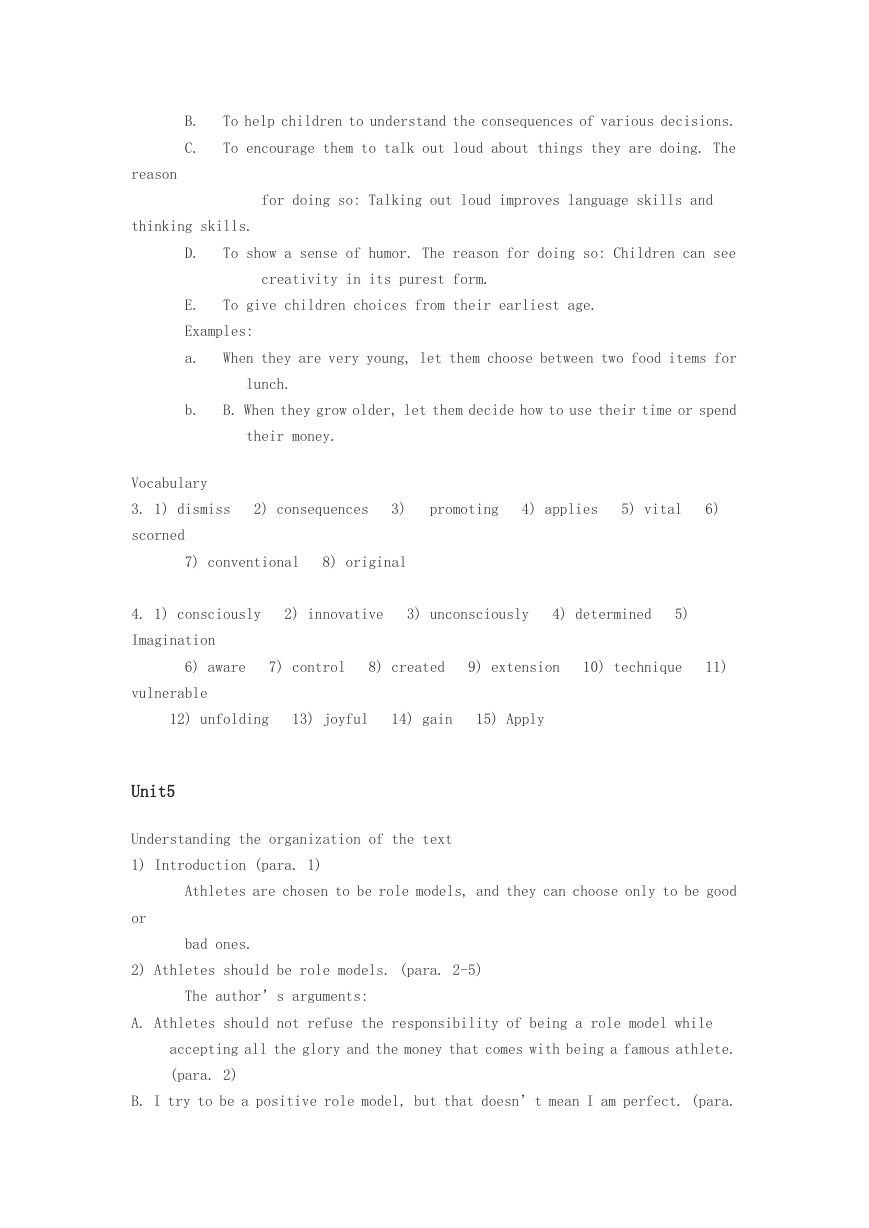
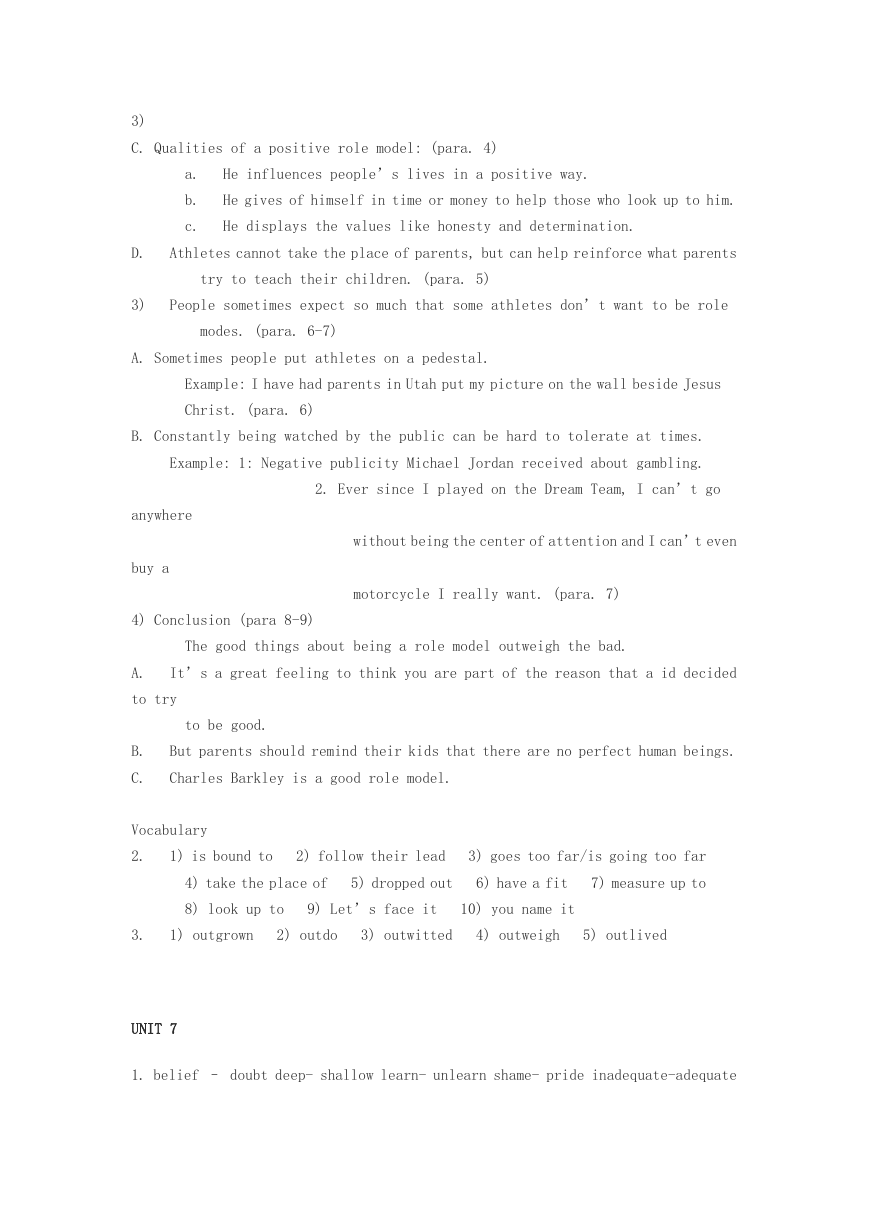








 2023年江西萍乡中考道德与法治真题及答案.doc
2023年江西萍乡中考道德与法治真题及答案.doc 2012年重庆南川中考生物真题及答案.doc
2012年重庆南川中考生物真题及答案.doc 2013年江西师范大学地理学综合及文艺理论基础考研真题.doc
2013年江西师范大学地理学综合及文艺理论基础考研真题.doc 2020年四川甘孜小升初语文真题及答案I卷.doc
2020年四川甘孜小升初语文真题及答案I卷.doc 2020年注册岩土工程师专业基础考试真题及答案.doc
2020年注册岩土工程师专业基础考试真题及答案.doc 2023-2024学年福建省厦门市九年级上学期数学月考试题及答案.doc
2023-2024学年福建省厦门市九年级上学期数学月考试题及答案.doc 2021-2022学年辽宁省沈阳市大东区九年级上学期语文期末试题及答案.doc
2021-2022学年辽宁省沈阳市大东区九年级上学期语文期末试题及答案.doc 2022-2023学年北京东城区初三第一学期物理期末试卷及答案.doc
2022-2023学年北京东城区初三第一学期物理期末试卷及答案.doc 2018上半年江西教师资格初中地理学科知识与教学能力真题及答案.doc
2018上半年江西教师资格初中地理学科知识与教学能力真题及答案.doc 2012年河北国家公务员申论考试真题及答案-省级.doc
2012年河北国家公务员申论考试真题及答案-省级.doc 2020-2021学年江苏省扬州市江都区邵樊片九年级上学期数学第一次质量检测试题及答案.doc
2020-2021学年江苏省扬州市江都区邵樊片九年级上学期数学第一次质量检测试题及答案.doc 2022下半年黑龙江教师资格证中学综合素质真题及答案.doc
2022下半年黑龙江教师资格证中学综合素质真题及答案.doc